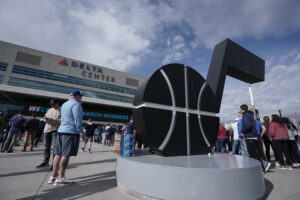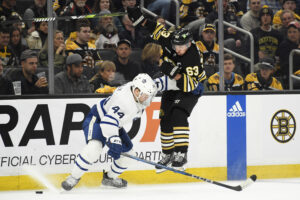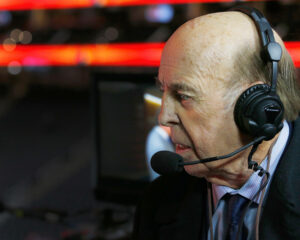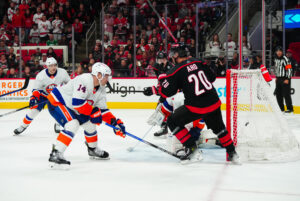Welcome to Puck Drop Preview 2016-17, where LastWordOnHockey.com gives you a detailed look at each team from around the NHL leading to the start of this hockey season and offers our insight and analysis. Make sure to stick around until the end of the series, where we’ll offer our full predictions for the standings in each division, and eventually our 2016-17 Stanley Cup pick. You can check out all our articles on our Puck Drop Page. Today the series continues with the Vancouver Canucks.
Puck Drop Preview: 2016-17 Vancouver Canucks
Last Season
Buoyed by a surprising yet ultimately disappointing appearance in the 2015 Stanley Cup Playoffs, the Vancouver Canucks entered 2015-16 with high hopes. The team had just witnessed a bounce back season from offensive leaders Daniel Sedin and Henrik Sedin, an influx of young talent, and had a new second line center in Brandon Sutter, while the goaltending duo of Ryan Miller and Jacob Markstrom gave fans some faith that another post-season berth could be in the cards.
However that didn’t take into account that 2014-15 was an aberration in the Pacific Division, with poor seasons from both the Los Angeles Kings and San Jose Sharks, who surprisingly failed to make the playoffs, giving the Canucks a window of opportunity.
Ultimately, even competing for a wild card spot ended up being a pipe dream. The team started well out of the gate, going 5-2-4 in October, but by mid-December it became apparent that the playoffs wouldn’t be in the cards for the Canucks.
Vancouver had a number of issues which ultimately conspired to sink the 2015-16 edition of the Canucks. First and foremost was a regression from the twins, as Henrik Sedin played through injury for much of the year and neither were able to approach their previous season’s point totals.
An injury to Sutter compounded the problem, as he had looked good early in the year in a top six role before ultimately appearing in only 20 games (scoring nine points). The Sutter injury pushed sophomore center Bo Horvat into a larger role, and while he ultimately adjusted (besting his rookie totals in both goals and points while leading the Canucks in scoring over the second half), early struggles left the team anemic on offense.
The club struggled all year to put the puck in the net, finishing with just 191 goals for, compared to 242 the season prior, a massive step backwards. In 2014-15 the club had 12 players finish with double-digit goal totals; last season, they had just six. Most egregious was Radim Vrbata, who led the team in goals with 31 the year prior but managed just 13 last season while struggling away from the Sedins.
There were however a few bright spots, as wingers Sven Baertschi and Jannik Hansen both set new career highs in goals with 15 and 22, respectively.
Defensively, the team was little better, seeing their goals against fall from a respectable 222 a season prior to 243 last season. The top pairing of Alexander Edler and Chris Tanev proved to be solid and rookie Ben Hutton had a surprising campaign (leading the Canucks blueline in scoring with 25 points), but the rest of the defensive group was a mess, which was particularly exposed when Edler and veteran Dan Hamhuis went down to injury.
The one saving grace was perhaps the goaltending. Miller and Markstrom proved to be the one preseason prediction which turned out better than expected, as they provided on most nights league average and occasionally spectacular goaltending on a team with one of the more porous defenses in the league (the Canucks allowed the second most shots against per game at 32.5). Despite that, Miller finished with a respectable save percentage of .916 (an improvement over the previous season), while Markstrom’s .915 served notice he had finally arrived as an NHL quality netminder.
Ultimately though, it was all for naught, as the team plummeted down the standings near the end of the season, finishing far outside of the playoff picture at 28th overall.
The Off-Season
Armed with the third best chance of winning the draft lottery, and potentially a shot at eventual number one pick Auston Matthews, it was thought that General Manager Jim Benning would have a great opportunity to upgrade his team over the off-season.
Benning began to make moves before the 2016 Stanley Cup Playoffs were even over, pulling the trigger on a trade which would see 19-year-old Jared McCann, who had impressed early with five goals in the first nine games of his rookie campaign, to the Florida Panthers along with two draft picks for 24-year-old defensive defenseman Erik Gudbranson. The move was viewed at the time (and still) as a win for the Panthers, however the club hopes Gudbranson can add some snarl to the back end, something that was desperately needed last year.
When it came time for the draft, luck was (as usual) not on the team’s side when it came to the lottery, as the Canucks tumbled down to 5th overall. Despite rampant rumors that the pick was in play, ultimately Vancouver chose to keep the pick, taking defenseman Olli Juolevi. The young Finn plays a very game likened by some to Marc-Eduoard Vlasic and portends to be a big part of the Canucks blueline in the future.
The Canucks then made an splash in free agency, signing Loui Eriksson, one of the most coveted wingers available, to a six-year, $36 million deal. To some the move was counter intuitive, as the team should be looking to get younger, not bringing aboard a (now) 31-year-old on a long-term deal, however Eriksson should provide a solid upgrade to the team’s offense and prove a good fit on the first line with the Sedins. If the intention is to be competitive, then bringing aboard a player of Eriksson’s caliber was the correct decision, even if that contract won’t looks so great in three to four years.
Rounding out free agency, the Canucks also signed Danish defenseman Philip Larsen to compete for a bottom pairing role, while they let blueliners Hamhuis and Yannick Weber walk.
The Forwards
Daniel Sedin – Henrik Sedin – Loui Eriksson
Jannik Hansen – Brandon Sutter – Anton Rodin
Sven Baertschi – Bo Horvat – Jake Virtanen
Emerson Etem– Markus Granlund – Derek Dorsett
Brendan Gaunce, Alex Burrows
Projecting the Canucks forward lines is no easy task, as the team is light on left wingers and heavy on centers, forcing many players to slide into unaccustomed positions. However the first line should be set in stone to start.
The most intriguing determinant will be Anton Rodin. The 25-year-old was drafted by the Canucks back in 2009 and finally looks ready to make an impact on the big club. Last season’s SHL MVP looks assured of a top six spot, and how he performs offensively will play a large role in how the forward trios shake out. Presumably he’ll line up with de facto second line center Sutter, while Hansen’s offensive output last season should earn him a look on the second line as well.
Horvat has a middle six center spot nailed down by this point, and the chemistry he showed with Baertschi last season should keep the duo together. However the winger on his other side is more up in the air. Jake Virtanen should be given every opportunity to snatch that spot in training camp.
On the fourth line, Markus Granlund was acquired last year from the Calgary Flames to play center, yet struggled upon his arrival in Vancouver. Further pushing Granlund is 22-year-old Brendan Gaunce, who finally got a look in the NHL last season and played well in a limited two-way role. However Gaunce can also play wing, allowing the club some flexibility up the middle should injuries occur. It’s hard not to put veteran Alex Burrows on the fourth line wing here, however Derek Dorsett and Emerson Etem will likely see time in this spot as well.
Overall the forward group lacks top line talent, but does have some NHL-caliber depth and flexibility for Head Coach Willie Desjardins to play with. Ultimately, with so many 25-and-under forwards, lots of lineup changes are to be expected based on the progression of these players, most notably Virtanen, who the Canucks hope can take a large step forward this season but could just as easily spend much of the campaign in the AHL with the Utica Comets.
The Defense
Alex Edler- Chris Tanev
Nikita Tryamkin – Philip Larsen
Luca Sbisa, Alex Biega, Andrey Pedan
The top pairing of Edler and Tanev will stay intact, as they proved the club’s most effective pairing last season and provide a nice mix of offense, defense and quick puck movement.
Hutton’s emergence last season was a surprise to many. Provided he does not suffer any sort of sophomore slump, he should be slotted into the second pairing alongside Gudbranson, and the duo should mesh well, as Gudbranson’s stay at home (read: has trouble getting the puck out of his zone) style will be augmented by Hutton’s ability to transition the puck up the ice quickly.
Where things get tricky is on the bottom pairing, where three players have a legitimate claim to a spot. Nikita Tryamkin, one of the Canucks most tantalizing prospects, showed both promise and growing pains last season. While he certainly needs more seasoning, he also has an out clause which would allow him to return to the KHL if the Canucks decide to send him down to Utica, meaning he must spend the balance of the season on the big club or risk losing him. Whether that is on the ice or in the press box remains to be soon.
Larsen was brought in ostensibly to provide some offensive pop for a blueline sorely in need of it. He hasn’t suited up in the NHL since 2013-14 with the Edmonton Oilers, but the 26-year-old looked good with Jokerit last season, netting 11 goals and 36 points in 52 games. If he can gain Desjardins’ trust, he could take over the role once held by Weber.
Then of course there is Luca Sbisa, the Vancouver fan base’s favorite whipping boy now that Matt Bartkowski has left town. Sbisa was one of the poorest possession players on the team last season and also has a penchant for making glaring errors. However management seems to have faith in the 26-year-old, and he seems to have the inside track at a roster position on opening night.
Alex Biega, Andrey Pedan and possibly even prospects Jordan Subban and Troy Stecher will be the first call-ups in case of injury, although Pedan must pass through waivers and could force the Canucks to carry eight defensemen to start the season.
Players to Watch
Bo Horvat
For years, Canucks fans have been wringing their hands over the fact the team has no heir to Henrik Sedin as the club’s number one center. However, Horvat may just have the ability to take that role, and this season will be determinant to learning if he can.
Last year Horvat started slowly but lead the Canucks in scoring over the season’s second half, serving notice that he may have more offensive upside to his game than previously thought.
With Sutter returning to the lineup, presumably for a larger portion of the season this year, Horvat will have the opportunity to settle into a comfortable role, playing less often against more formidable opponents, as he was forced to do many times last year.
Also perhaps helping Horvat in his evolution this year will be the additions of Doug Jarvis and Manny Malhotra to the coaching staff, both of whom should help the young center improve his game, especially in the face-off circle.
While Horvat will never be a high-octane number one center in the mold of a Sidney Crosby or Tyler Seguin, it wouldn’t be inconceivable to see him mentioned in the same breath as players like Patrice Bergeron or Jonathan Toews, given his strong two-way play. This season will go a long way towards determining whether that is a reality, or just a collective pipe dream of the Vancouver faithful.
Nikita Tryamkin
Listed at 6’8″, it’s hard to miss Tryamkin on the ice, however there’s much more to this rough prospect worth keeping an eye one.
Tryamkin has a great stick and surprising agility for a man of such a hulking visage. The comparisons to Zdeno Chara are inevitable and have kept Canucks fans drooling since Tryamkin was drafted by the club in the third round in 2014.
Can Tryamkin ultimately evolve into a Chara-level defender however? That’s the question on everyone’s mind. He showed flashes of such ability during his brief 13-game debut last season, but he also at time struggled with his time and spacing as he adjusted to the NHL ice surface.
All the tools are there, Tryamkin just has to learn how to use them to be effective. Just 22 years old and still incredibly raw, Tryamkin will certainly be worth watching. How he adjusts to the NHL in his first full season in North America will go a long way toward finding out just what this monster of a blueliner can become.
On The Rise
Jake Virtanen
The former 6th overall pick in the 2014 NHL Entry Draft made the club out of training camp last season and kept his roster spot after the first nine games (during which he only scored three points). At the time many doubted whether it was worth it to keep Virtanen in the NHL versus sending him back to junior.
While Virtanen certainly learned a lot during his first 55 games of NHL action, in addition to being one of the better possession players on the club (albeit in 11:34 of ice time per game), he struggled to find his offensive game, tallying only seven goals and 13 points. Further painting Virtanen with a negative brush was his disappointing performance at (and reaction to) the 2016 World Junior Championships, where he managed just one assist and Team Canada finished 6th. There was also the odd incident where Virtanen’s social media accounts suddenly went dark after a night hanging out with pop star Justin Bieber.
The question for Virtanen and certainly for Canucks management is whether or not Virtanen has gotten past those growing pains and is ready to take the next step towards becoming a responsible, mature, offensively productive power forward at the NHL level.
Early word out of training camp is that Virtanen not only looks fit but also focused, something the 20-year-old will need to secure a roster spot this season because, unlike last year, Virtanen can be sent down to the AHL this season. Whether in Vancouver or Utica, Virtanen will be looking to take a large step forward in his development this season.
Thatcher Demko
Once known as the “goalie graveyard,” Vancouver is quickly becoming known as a place where goalies find their elite game. The credit for that undoubtedly falls to Goalie Coach Rollie Melanson, who has helped Roberto Luongo, Cory Schneider, Eddie Lack and Markstrom all take their game to the next level.
When Melanson indicated at the end of last season that he would be taking a step back, many in Vancouver lamented the loss of the guru. However it turned out Melanson was staying in the organization as a player development goalie coach, while former Canucks netminder Dan Cloutier would be taking over full time in Vancouver.
What this all means is more one-on-one time between Melanson and Thatcher Demko, who might just be the best goalie prospect the Canucks have ever had.
Demko is turning pro this year after a sterling college career in which he was a Hobey Baker Award finalist last year and captured the Mike Richter Award as best goalie in the NCAA after posting an unbelievable 27-8-4 record with a 1.88 goals against average, .935 save percentage and 10 shutouts (smashing Schneider’s Boston College record in the process).
The sky’s the limit for Demko as he begins his rookie campaign in Utica, where he will be handed the starter’s role and given a copious number of reps. He’s following essentially the same developmental path as Schneider before him and will be given plenty of time to percolate, but it seems its just a matter of time before Demko is the main man in the Vancouver crease.
On The Decline
The Sedins
Drafted as a fresh-faced (they looked about 12 years old) curiosity second and third overall in 1999, it’s amazing to think that moment was now more than 17 years ago, and the Sedins are firmly in the midst of the twilight of their careers.
Still as cerebral as ever and among the most unique visionaries on the ice the NHL has ever seen, there’s no doubt time and injuries have caught up to the Swedish twins, who were never all that fleet of foot to begin with.
As they have every year since the demise of the famed West Coast Express line of Markus Naslund, Todd Bertuzzi and Brendan Morrison in the mid-2000s, the Sedins will be expected to carry the offensive load again this season, a task which becomes taller with each passing year.
Last season Daniel Sedin paced the team in both goals and points (28 and 61, respectively), while brother Henrik finished with 55 points, albeit in 74 injury-plagued games (Daniel played the full 82). The addition of Eriksson should provide the Sedins with a boost, particularly on the power play, where they used to feast on defenders with their astute board work and innate cycling skills, but expecting anything more than the twins holding steady offensively would be foolish at this point, as their point per game days appear to be behind them.
They’re still among the best thinkers in the game, but the hands (and legs, and backs, and etc.) can only hold on for so long.
Jannik Hansen
Hansen had the luxury of playing along side the Sedins last year, and unsurprisingly given that plumb role scored a career-high 22 goals and 38 points, at age 30. Heading into 2016-17, everything about that last sentence should be worrisome.
For starters, the addition of Eriksson will push Hansen down the lineup, where the offensive opportunities won’t come so easily. Secondly, players who have career seasons at 30 years old are rarely able to improve upon them.
Hansen remains the most effective penalty killer on the club (and one of the best in the league), however expectations are too high that he will repeat his offensive production from last year. Whether he plays alongside Sutter or Horvat, the club’s middle six will be richer for having the Danish winger in the mix, however we’ve already seen his best offensive days.
2016-17 Season Projections
There are a multitude of factors that need to go right in order for this club to have any success this season: The top line will need to be an offensive force, the middle six will need to provide the required secondary scoring, the defense will need to prove stouter than the season before, the young players need to take the next step in their progression, the special teams play will need to be tightened up, and one or both goalies will need to play beyond their expectations.
Are any or all of those things possible? Sure, however Canucks fans have been conditioned to expect the worst, and it’s not unlikely that more than a few expectations won’t come to fruition. Even if everything goes right, a wild card berth will be a struggle. That said, this is a club on the rise with a solid stable of young prospects just about ready to come into their own.
We may not see those results this season however, and it will be another long campaign for the Vancouver faithful. Expect the Canucks to see some marginal improvement yet still again finish near the bottom of the Western Conference.
Main Photo:






